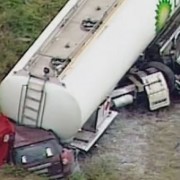The Trucking Industry’s Call For Consistent Roadworthiness Rules
 The trucking industry is still seeking consistency in roadworthiness rules, with the Australian Trucking Association (ATA) putting forward a submission in response the National Transport Commission’s consultation regulatory impact statement on heavy vehicle roadworthiness.
The trucking industry is still seeking consistency in roadworthiness rules, with the Australian Trucking Association (ATA) putting forward a submission in response the National Transport Commission’s consultation regulatory impact statement on heavy vehicle roadworthiness.
The ATA’s Chief Executive, Chris Melham earlier this year called for any changes made to the heavy vehicle roadworthiness system to bring about uniformity in roadworthiness rules and enforcement.
Melham was speaking about the ATA’s submission to the NTC,
“The trucking industry is strongly in favour of nationally uniform enforcement, including standard rules for vehicle inspections and defect assessments,” Mr Melham said.
“The current roadworthiness rules are sometimes applied haphazardly or wrongly at the roadside. Clear, nationally accepted rules need to be established for declaring a vehicle roadworthy, and for issuing and clearing minor and major defect notices. There must also be consistent national training for enforcement officers,” he said.
Source: www.truck.net.au
In April Mr Melham called for the Chain of Responsibility concept to be extended to vehicle roadworthiness, as the ATA has long been recommending.
In light of this the ATA has submitted a recommendation on reforms to the chain of responsibility which included extending CoR to heavy vehicle roadworthiness. They also advocated for more consistency and simplicity in the law. Mr. Melham explained:
“The ATA has put forward a comprehensive set of reforms to chain of responsibility, which would extend CoR to roadworthiness while at the same time reducing the complexity of the law,” he said.
Source: www.truck.net.au
Mr Melham went on to urge governments not to make any changes to periodic scheduled inspections without collating more evidence. Currently some states require each truck to inspected annually, despite its risk profile, while other states do not.
Mr Melham continued,
“The NTC consultation RIS acknowledges there is inadequate evidence (and often conflicting information) about the effectiveness of roadworthiness policies, and for periodic scheduled inspections in particular,”
“Scheduled inspections are a rigid, high-cost enforcement tool. It is often said that they only establish roadworthiness on one day of the year: the day a truck is inspected.
Source: www.truck.net.au
He explained that no solid evidence exists to support the introduction of scheduled inspections in states where they aren’t undertaken currently. He says there is also no solid evidence to support removing them in the states that do require them.
Melham explained that lack of evidence for or against scheduled inspections leads the ATA to support waiting off on making any major and costly policy decisions on the subject. There is little evidence in line with the principles of evidence-based policy, according to Melham so waiting on the issue until there is more evidence would be the ‘prudent’ thing to do according to Melham.
Instead Melham suggested the state governments fund a major case control study for more indepth information,
“The submission recommends that governments should fund a major case-control study to provide more information about the links between vehicle inspections, vehicle roadworthiness and accidents, to inform future decisions about the effectiveness of these inspections,” he said.
Source: www.truck.net.au


